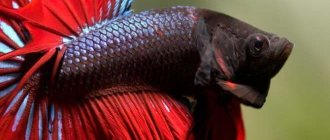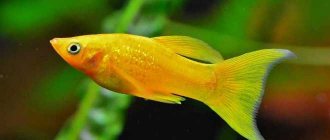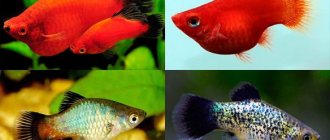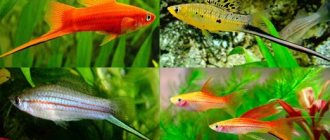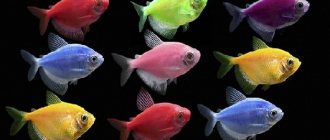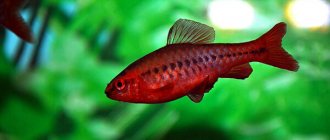Description
Valued for its unusual color, ability to reproduce in a community aquarium, and livability.
Appearance
The body is elliptical, elongated. Laterally compressed. The mouth is large, oriented upward. The color of the body and fins is velvety black. Aquarists consider the presence of light spots to be a defect.
The latest achievement of breeders is the tail fin of the black molly in the shape of a rotated letter “Ω”. The ends are pointed. There are varieties with the dorsal fin extended towards the tail.
Males grow up to 50–60 mm, females – up to 60–80 mm.
Lifestyle
They are mobile in all areas of the aquarium and playful. Males are especially active. In an overcrowded tank and when there is a shortage of females, they are aggressive towards their relatives and defend the territory. Keep at a rate of 2 females to 1 male.
The situation is similar with a lack of food. Only females show aggression.
In nature, they are schooling fish. In captivity, gregariousness is less pronounced.
Lifespan
The black molly fish lives 3–3.5 years.
Treatment of aquarium fish
Many aquarium fish lovers are concerned about the question of how to treat them. The most common and do not require complex care are viviparous fish, such as, for example, mollies. One of the most frequently asked questions among novice aquarists is: “What to do if the mollies are covered with white spots or dots, become lethargic and inactive?”
Firstly, it means that the fish are sick. They, like people, experience physical discomfort when unwell, so try not to make noise or turn on too bright lights in the room. Then you need to determine what exactly your fish is sick with. This may be one of two similar diseases.
The first has the following symptoms: in addition to white dots, the fish loses the brightness of its color, its body acquires a glossy shine, a milky coating, the fins become frayed and can peel off, and at a later stage of the disease the coating becomes more velvety, and the mucous membrane begins to peel off. This disease is called odynosis (in common parlance - velvet disease).
Content
Black mollies are considered an unpretentious fish, but they are more demanding than other types of platies in terms of living conditions. Sensitive to temperature conditions. Prefers hard, clean water. Air purging is desirable, filtration is required.
Provide a lighted swimming area in the center of the container. Place shelters in the form of plants or stones, snags, grottoes.
Don't keep molly alone. The ideal option is 1 male for 3 females. Reduces male hostility.
Aquarium size
Provide a spacious aquarium: from 15 liters per couple in a common aquarium. From 50 liters when keeping a flock of 3 individuals separately. Mollies do not tolerate acidic environments.
Water parameters
- Water temperature: 23–28° When the temperature drops below 21°C, they are little active and do not grow. The color fades.
- Hardness: 5–20 °F.
- Acidity: pH 7.5–8.5.
If acceptable for other inhabitants, mix in sea salt: 2–4 grams per liter (2–4‰). A heaped teaspoon contains 10 g, without it - 7 g. Other inhabitants will not like the saltiness.
To maintain acidity standards, change 1/4 of the water volume weekly. Old water becomes acidic.
Plants
Mollies tend to eat soft plant foliage. Give preference to greens with rough leaves.
- Vallisneria can withstand salinity up to 20‰.
- Stiffleaf arrowhead (sagittarium).
- Java moss is a ready refuge for fry.
- Riccia grows faster than it can be eaten.
- Elodea floats in the water column or is fixed. They won’t have time to eat it: it will grow back and will have to be cut.
- Indian fern (water cabbage).
Fry and females hide in dense thickets during spawning.
Priming
Doesn't matter. But black molly looks good against a light background.
Decorative elements
Stones and driftwood serve as a refuge for fish. Females rest behind them from the activity of males.
Treat snags with caution. Incorrectly prepared, lower pH.
Optional equipment
- Compressor with sprayer. Air blowing will be needed in an overcrowded aquarium and when there is a lack of plants. The productivity for aeration is from 0.8 liters of air per hour per 1 liter of water.
- An internal filter is suitable for containers up to 150 liters. With connection to a compressor. Otherwise - external. Pumping capacity is required from 8 volumes per hour. The current created is familiar to mollies.
- Siphon for cleaning the bottom from food debris and waste.
- Heater equipped with a thermostat. For large aquariums, a submersible horizontal ground one is convenient. Does not need to be turned off when changing water.
- Thermometer.
- Scraper for removing algae from front glass. There is no need to clean the back and sides if there are no decorations. Black molly eats green growths with pleasure.
- Net with frame from 4".
Lighting
The backlight is bright, the luminous flux is 80–100 lumens per liter. Choose LED and fluorescent light sources with a color temperature of 5000 K. The lamps are energy saving. The aquarium does not heat up.
Daylight hours are 11–13 hours.
Aquarists recommend 2-3 hours of natural light and sunlight per day. The benefits of “tanning” are not justified. But algae infestation is guaranteed. Some of the parasites will be eaten by mollies. But not all types of unwanted vegetation cannot cope with the rapid growth of weeds.
The active growth of algae is provoked by ultraviolet radiation and the presence of nitrites and ammonia in the water.
Feeding
Black molly is an omnivorous fish. Relatives in nature feed more on plant food. Aquarium hybrids need a varied diet.
Feed 1-2 times daily. In addition to the mandatory fasting day.
Live food
Bloodworms and tubifex are high in calories and contain essential substances and vitamins. Regular eating causes obesity. They are mined at the bottom of standing reservoirs. There is a risk of introducing parasites and infections, and fish poisoning.
The coretra is not so dangerous because it lives and feeds in the water column. Not as nutritious.
Daphnia, gammarus and brine shrimp are bred at home. Experienced aquarists solve the problem of the safety of live food in this way. Nauplii, Artemia larvae, are used to feed the fry.
- Live food contains nutrients and beneficial substances in a form accessible to fish.
- Uneaten, does not spoil water.
- Caught in dirty waters is dangerous.
Frozen food
Safe against infections and parasites. Even products from trusted manufacturers poison fish. During storage and delivery, there is a possibility of defrosting, which is unacceptable.
- Contains the same ingredients as live food.
- It is necessary to siphon off the remains.
- Risks poisoning.
Dry food
It is produced in the form of powders, flakes and tablets. The food is balanced and contains vitamins, micro- and macroelements. Manufacturers:
- Hikari;
- Zoomworld;
- Tropical;
- Aller Aqua;
- TETRA;
- SERA;
- JBL.
If you are leaving, install an automatic feeder with a timer.
- No preparation required.
- Contains the necessary ingredients.
- Safe.
- The presence of the owner is not required.
- Residues must be removed.
Plant food
- Black mollies need plant fiber. Plant food makes up 30% of the diet.
- Spirulina tablets and flakes. Spirulina is a cross between a bacterium and an algae. This makes the composition specific. Not enough fiber (9-11%). The vitamins, micro- and macroelements contained will strengthen the immune system. Blanched vegetables - cucumber, zucchini, cabbage. Spinach and greens will do. Dried nettle is rich in vitamins.
- Crushed and blanched oat flakes (“Hercules”), semolina.
Top dressing
Used to diversify the diet. Feed with hard-boiled chicken egg yolk. Chopped boiled meat, liver. Chopped sea fish. Raw river fish should not be given due to the presence of parasites and infections.
General recommendations
- None of the listed foods are suitable for constant feeding. Diversify your diet.
- A lack of plant food in the diet will affect the condition of the plants. The black molly will eat the algae and attack the grass.
- Overfeeding threatens gastrointestinal disorders and obesity. Don't forget about fasting days.
- Remove uneaten food. It spoils the water and provokes the growth of algae.
Disease prevention
You can avoid an unpleasant disease by following a few simple rules:
- Before new pets are brought into the main tank, they must serve a two-week quarantine period. All this time, the fish must be monitored so as not to miss their possible health problems.
- The aquarium needs to be cleaned periodically: replacing some of the water, going over the soil with a siphon, washing the filter and cleaning the glass from the accumulated layer.
- Any decorative items, soil and plants must be treated in solutions or boiling water before decorating the tank with them.
- Constant monitoring of the condition of your fish will help you quickly detect negative changes and prevent the development of diseases in the early stages - quickly and cost-effectively.
There are many tips for eliminating semolina from aquarium fish, treatment and prevention. Some of them cause controversy among aquarists with many years of experience.
Have you encountered ichthik, and what methods have become effective for you? We will be glad if you share your personal experience in the comments!
Compatibility
Black mollies get along with a variety of neighbors. Large predators, catfish, are contraindicated. The skin of goldfish is covered with mucus, which the mollies eat along with their scales and fins. Males conflict with tiger barbs.
Keeping with other platies is not recommended. Due to cross insemination.
They live harmoniously with all viviparous animals.
Reproduction
Occurs without stimulation under recommended conditions. Molly is a viviparous fish. Black molly fry are active from the moment of birth and hide from adults. Reproduction in a community aquarium is acceptable. They will survive healthy and with a reaction.
For breeding, pregnant mollies are placed in an internal spawning tank or a separate container.
How to distinguish a male from a female
Females are larger than males, the anal fin is triangular. The male has a fin in the form of a gonopodium, a thin tube for fertilizing eggs in the female’s abdomen.
Gender change
Female mollies change sex. Before childbirth, after childbirth. Age doesn't matter. The reason is unknown. Typical for platies.
Spawning
In mollies this occurs continuously. The male pursues females, actively moving his gonopodium. Pregnancy is determined by a swollen abdomen. The first pregnancy lasts 30–40 days.
2-3 days before birth, the abdomen “squares up”. Place the fish ready for marking in a container with an abundance of plants. Greenery and mosses will serve as shelter for the fry. Females eat the fry right during birth.
For the first time, up to 50 fry are born. An adult fish brings up to 200. After giving birth, the female is returned to the general aquarium.
The male's seed is retained. A pair of births without a male is possible. A breeder's nightmare.
It is not recommended to keep fry in a cramped indoor spawning tank. They develop poorly and are not afraid of large fish.
Change 1/3 of the water 3-4 times a week.
Feed the fry “live dust”, nauplii. Pet stores sell powdered food for juveniles. Grinded adult dry food is suitable. Plant food - phytoplankton, ground oatmeal. Get phytoplankton yourself by exposing a jar of water to sunlight for a couple of days. When it blooms, add it to the vessel with the fry. Feed with egg yolk and egg powder rubbed through a fine mesh net.
When the first sexual signs appear, separate females from males. Early pregnancy is disastrous. Males reach puberty in 9–11 months, females in 4.5–5.5. Males are transferred to a general aquarium when they grow to 15 mm.
Advice. To preserve the breed, discard fry with light spots.
Interesting facts about mollies
- The appearance of mollies fry always occurs at dawn.
- Mollies sometimes experience degeneration, that is, a change in sex. This can happen both at an early age and in adulthood.
- The number of babies is determined by the size of the female. As a rule, a large female produces more offspring. The largest number of fry in one birth is 280 pieces.
- Mollies with a black body color are not a separate species. Instances of this color can appear within any species of these fish.
- There have been cases of white fry from black spawners. This is explained by heredity and connections with previous generations. The white coloration of the fry is not always preserved - sometimes during the 1st month of life, black spots appear on the body of the fish, which become more and more numerous over time.
Diseases
Black mollies are prone to disease. Before starting treatment, carry out tests and check the water parameters. Control the content of nitrates, nitrites, ammonia.
Contagious diseases
Ichthyophthiriasis (“semolina”) manifests itself as white spots-growths on the scales and fins. Caused by ciliate parasites. Treatment:
- Super Ick Cure from Aquarium Pharmaceuticals.
- Faunomor from Aquarium Munster.
- Sera Costapur.
- Ichthyophorus from “Zoomir” (in difficult cases).
Proceed in accordance with the attached instructions.
Oodiniosis (“gold dust”) is similar to semolina, but the spots are golden in color. Infection with skin parasites. It is treated with JBL Oodinol according to the instructions.
Salt baths with potassium permanganate help with parasitic and fungal diseases. Ichthyophthiriasis will not be cured.
- Prepare 2 separate vessels with a solution of potassium permanganate (“potassium permanganate”). Pink colour. Capacity - from 5 l.
- Add salt to the first at the rate of 30 g/l, to the second - 60 g/l. Stir and equalize the temperature with the aquarium temperature.
- Transfer the fish to the first container for 15 minutes.
- Swish in the second container in a net for about 1 minute to remove parasites.
- Place the mollies in the aquarium. Repeat the procedure daily for 3 days.
Cold
Occurs when water cools suddenly. Symptoms: lack of appetite, inactive, swimming near the surface.
Restore the recommended thermal conditions.
Poisoning
Oxygen poisoning is an excess of oxygen content. It occurs due to the replacement of unsettled water and excessive air ventilation of a planted aquarium. Symptoms: restless behavior, darkening of the gills.
Chlorine poisoning occurs when replacing unsettled chlorinated water. Symptoms: rotation around the longitudinal axis, attempts to jump out. Treatment: place the sick person in settled water, perform intensive air ventilation of the vessel.
Ammonia poisoning. Reasons: contamination of the bottom or filter with organic matter. Symptoms: active inappropriate behavior, seizures. Lying on the ground with open mouth and gills. Treatment: transplant into a container with settled water in another aquarium. Replace water, remove contaminants.
Development and symptoms of the disease
The development of the disease generally proceeds as follows. First, the pathogen, ichthyophthirius, is introduced into the aquarium in one way or another. This is a ciliated ciliate that lives in both warm and cold water bodies around the world.
Ichthyophthiriasis
It attacks the epithelium of fish and provokes the appearance of white spots on it with a radius of about 1 mm. Spreading from the fins to the gills and mouth, and then throughout the body.
Affected individuals begin to rub against decorations and vegetation in an attempt to get rid of the ciliates. Lose mobility, appetite and weight. On approximately the 5th day of parasitism, the pest releases up to 1000 invisible “vagrants” looking for new victims.
The “larvae” can exist for 55 hours. If the disease is not noticed in a timely manner and assistance is not provided. The consequences can be very severe, including the extinction of the entire aquarium.
Reviews
Aquarists value the black molly for its appearance and livability. Ability to produce offspring in a community aquarium. Does not require separate food.
Dissatisfied with eating plants. I'm not happy with the appearance: it's gloomy. Cases of unexpected aggression have been recorded.

